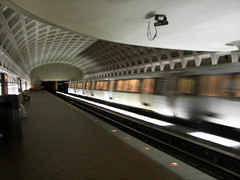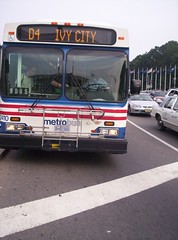Buses and subways and trains, oh my.
The Beyond DC blog's post on why late night subway service shouldn't be eliminated, see "Metro =/= MARC" makes a good case. Whereas I wimped out, suggesting that WMATA offer trunkline bus service along the WMATA route in the hours that the subway system is down (which is still a good idea), Dan says don't cave.
He's right. Plus, it makes me realize that John Catoe probably is the wrong person for the WMATA job. Dan is right that Mr. Catoe was hired to improve bus service. Maybe that's the job that he should have. And we should hire someone to stabilize, strengthen, and expand and extend the transit system too, to be the "system's" "General" "Manager."
Maybe hiring Mr. Catoe is an example of satisficing, of the Board of Directors of the system, being politicians after all, not willing to stake the future of the region (especially the urban parts of the WMATA system) on transit-based mobility.
This makes sense because politicians aren't known for a focus on "system transformation" but they are more about system maintenance and a bit of "system change" on the edges. (See Friedmann's _Planning in the Public Domain_ and past blog entries on this topic--do a search...)

Similarly, I have commented that Michelle Rhee is probably the wrong hire for DC's school system--not that she doesn't care or doesn't have the energy and will--but because her expertise is in hiring teachers, and the most significant change required is in the overall organization of the system, its organizational culture and focus.
Getting back to transit, and the title of Dan's blog entry, this doesn't even cover railroad passenger service in the region. The region needs one combined railroad passenger transportation system too, not two separate systems that are state-based, and the creation of a system that provides 24/7/365 service. And yep, Dan has written about that in the past, and so have I.
A BeyondDC concept map for how a regional railroad system could look.





0 Comments:
Post a Comment
<< Home